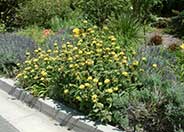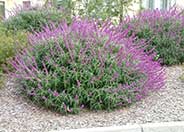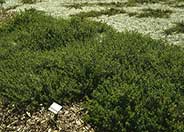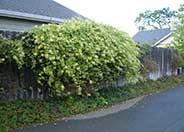
Common name:Jerusalem Sage
Botanical name:Phlomis fruticosa
This hardy perennial is a useful, old-time garden plant with coarse, woolly gray green, wrinkled leaves and yellow, 1" flowers in ball-shaped whorls. It handles drought and poor soils but needs full sun.

Common name:Mexican Bush Sage
Botanical name:Salvia leucantha
The Mexican Sage is a bushy shrub that grows 3'-4' tall and wide. It has hairy white stems, gray green leaves and velvet-like purple flower spikes that bloom summer through fall. This shrub tolerates sun, light shade, little water, and is hardy to 15 degrees F. The Mexican Sage is drought tolerant and attracts hummingbirds. -Cornflower Farms

Common name:Coyote Bush
Botanical name:Baccharis pilularis 'Pigeon Point'
'Pigeon Point' is a compact, evergreen groundcover that grows 18"- 24" tall and 10'-12' wide. It is the preferred form of the Coyote Bush. Its leaves are green; it has white flowers that bloom in the fall. It is important to plant this groundcover that are at least 6' -10' apart. Otherwise they will overgrow each other and create a high groundcover. 'Pigeon Point' is tolerant of ocean spray and is deer resistant.

Common name:Hall's Japanese Honeysuckle
Botanical name:Lonicera japonica 'Halliana'
The 'Halliana' is a vigorous, hardy, climbing vine with deep green, oval leaves and fragrant white flowers that change their color to yellow. It is good as a groundcover or for covering fences. This is a highly combustible plant.
Sustainable Landscaping Fundamentals
Sustainable landscaping is a term coined to mean sensible landscape practices that work within the limits of the Eco-system. This means within the limits of your local rainfall, soil conditions and sun patterns.
Click in the green box for more information
| Designer: | Phlomis Sentenials |
Photographer: GardenSoft |
Soils and Compost:
Practice grass-cycling by leaving short grass clippings on lawns after mowing, so that nutrients and organic matter are returned to the soil.
Water Saving Tip:
Be sure to fix all leaks promptly no matter how small they may seem.
Integrated Pest Management:
Remove irrigation water and fertilizer from areas where you don't want weeds to grow.

